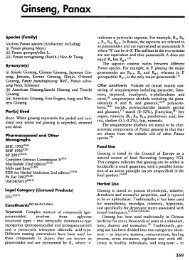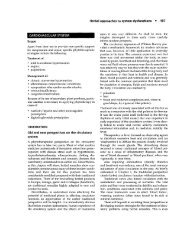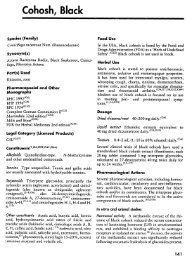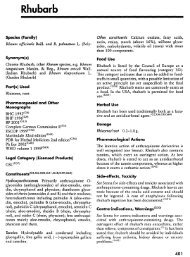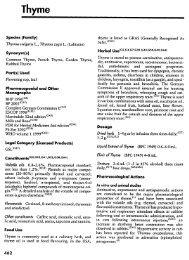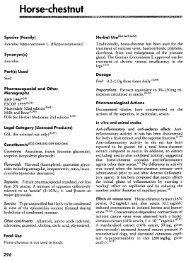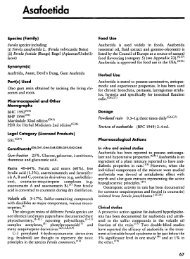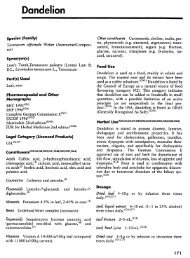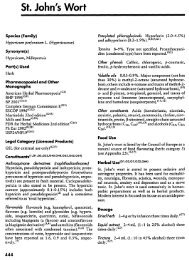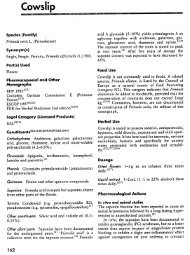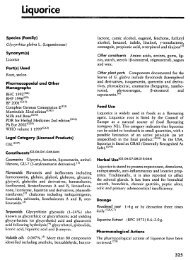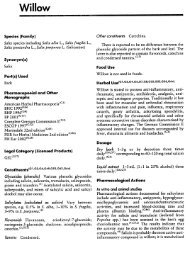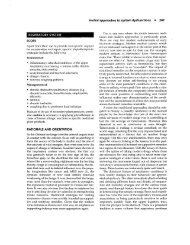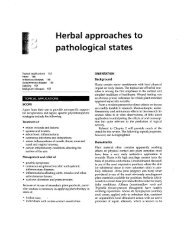Melissa
Melissa
Melissa
You also want an ePaper? Increase the reach of your titles
YUMPU automatically turns print PDFs into web optimized ePapers that Google loves.
<strong>Melissa</strong><br />
Species (Family)<br />
<strong>Melissa</strong> officinalis L .<br />
Synonym(s)<br />
(Labiatae)<br />
Balm, Honeyplant, Lemon Balm, Sweet Balm<br />
Part(s) Used<br />
Dried leaves and flowering tops<br />
Pharmacopoecal and Other<br />
Monographs<br />
BHP 1996 (G9)<br />
BP 2001 (G15)<br />
Complete German Commission E (Lemon Balm) (W)<br />
ESCOP 1996 (G52)<br />
Martindale 32nd edition (Lemon Balm) (G 43)<br />
Mills and Bone (Lemon Balm) (G501<br />
PDR for Herbal Medicines 2nd edition (G36)<br />
Ph Eur 2002 (G28)<br />
Legal Category (Licensed Products)<br />
GSL (G37)<br />
Constituents (G2,G52,G64)<br />
Volatile oil 0 .06-0.375% v/m (volume in<br />
(1,G52)<br />
mass) . Contains at least 70 components,<br />
(G2)<br />
including : Monoterpenes >60% . Mainly aldehydes,<br />
including citronellal, geranial, neral ; also citronellol,<br />
geraniol, nerol, (3-ocimene . (2,3) Sesquiterpenes >35% .<br />
(3-Caryophyllene, germacrene D .<br />
Flavonoids 0.5% . Including glycosides of luteolin<br />
(e .g . luteolin 3'-O-(3-D-glucuronide (4) ), quercetin, apigenin<br />
and kaempferol .<br />
Polyphenols<br />
Protocatechuic acid, hydroxycinnamic<br />
acid derivatives, (2) caffeic acid, chlorogenic acid,<br />
rosmarinic acid '(2) 2-(3',4'-dihydroxyphenyl)-1,3-<br />
benzodioxole-S-aldehyde . (5)<br />
Food Use<br />
Lemon balm is used to give fragrance to wine, tea and<br />
beer . Lemon balm (herb, flowers, flower tips) is listed<br />
by the Council of Europe as a natural source of food<br />
flavouring (category N2) . This category indicates<br />
that lemon balm can be added to foodstuffs in small<br />
quantities, with a possible limitation of an active<br />
principle (as yet unspecified) in the final product<br />
. 16 > In the USA, lemon balm is listed as GRAS<br />
(Generally Recognised As Safe) . (G65)<br />
Herbal Use<br />
Lemon balm has been used traditionally for its<br />
sedative, spasmolytic and antibacterial properties<br />
. (G54) It is also stated to be a carminative, diaphoretic<br />
and a febrifuge, (G64) and has been used for<br />
headaches, gastrointestinal disorders, nervousness<br />
and rheumatism!) Current interest is focused on its<br />
use as a sedative, and topically in herpes simplex<br />
labialis as a result of infection with herpes simplex<br />
virus type 1 (HSV-1). The German Commission E<br />
monographs state that lemon balm can be used for<br />
nervous sleeping disorders and functional gastrointestinal<br />
complaints . (G4)<br />
Dosage<br />
Dried herb 1 .5-4 .5 g as an infusion in 150 mL water<br />
several times daily . (G4)<br />
Topical application<br />
Cream containing 1 % of a lyophilised<br />
aqueous extract of dried leaves of <strong>Melissa</strong><br />
officinalis (70 : 1) two to four times daily . (G52)<br />
Pharmacological Actions<br />
In vitro and animal studies<br />
Antiviral activity Aqueous extracts of <strong>Melissa</strong> officinalis<br />
have been reported to inhibit the development<br />
of several viruses . (6-s,GS2) The virucidal effect of<br />
several aqueous extracts of M . officinalis against<br />
HSV-1 has been demonstrated in a rabbit kidney<br />
cell line .' ) However, the extracts appeared to have<br />
no activity against experimental HSV-1 infection in<br />
the eyes of rabbits .' )<br />
Anti-human immunodeficiency virus type 1 (HIV-<br />
1) activity has been reported for an aqueous extract<br />
of M . officinalis in in vitro studies using MT-4 cells ;<br />
the ED 50 (50% effective dose for inhibition of HIV-1-<br />
induced cytopathogenicity) was found to be 16 gg/<br />
ml. ." 0) Furthermore, the aqueous extract demon-<br />
337
338 <strong>Melissa</strong><br />
strated potent inhibitor activit (ED 50 =62Vg/mL)<br />
against HIV-1 replication (KK-1 strain, freshl isolated<br />
from a patient with acquired immune deficienc<br />
sndrome (AIDS) . In other in vitro studies, an<br />
aqueous extract of M . officinalis inhibited giant cell<br />
formation in co-cultures of MOLT-4 cells with and<br />
without HIV-1 infection, and showed inhibitor<br />
activit against HIV-1 reverse transcriptase<br />
(ED50=1 .6 pg/mL) . (10<br />
Aqueous extracts of M . officinalis have been<br />
reported to inhibit protein biosnthesis in a cell-free<br />
sstem from rat liver cells, and it has been suggested<br />
that this effect ma be due to caffeic acid and a<br />
component isolated from the glcoside fraction of<br />
the extract! 11) The latter component appears to<br />
block the binding of the elongation factor EF-2 to<br />
ribosomes, thus terminating peptide elongation . (11)<br />
Antimicrobiol activit Antimicrobial activit of<br />
essential oil extracted from M. officinalis b steam<br />
distillation, determined using a micro-atmospheric<br />
technique, has been reported against the easts Candida<br />
albicans and Saccharomces cerevisiae, and<br />
against Pseudomonas putida, Staphlococcus aureus,<br />
Micrococcus luteus, Mcobacterium smegmatis,<br />
Proteus vulgaris, Shigella sonnei and<br />
Escherichia coli . (12)<br />
Other activit In studies in mice, a hdroalcoholic<br />
extract of M . officinalis leaves administered intraperitoneall<br />
significantl reduced behavioural activit in<br />
two tests, compared with control, suggesting that the<br />
extract has sedative effects . (13) In both tests, the effect<br />
was maximum at 25 mg/kg. The same extract demonstrated<br />
peripheral analgesic activit b reducing<br />
acetic acid-induced writhing and stretching in mice<br />
when administered intraperitoneall at doses of 25-<br />
1600 mg/kg 30 minutes after intraperitoneal administration<br />
of 1 .2% acetic acid solution . (13) However,<br />
no analgesic effects were observed on heat-induced<br />
pain (hotplate test) which suggests a lack of central<br />
analgesic activit. In other tests, low doses (3 and<br />
6 mg/kg) of a hdroalcoholic extract of M . officinalis<br />
leaves administered intraperitoneall induced sleep in<br />
(13)<br />
mice given an infrahpnotic dose of pentobarbital .<br />
B contrast, in the same batter of tests, essential oil<br />
obtained from M . officinalis b distillation did not<br />
demonstrate sedative or sleep-inducing effects . (13)<br />
A 30% alcoholic extract of M. officinalis demonstrated<br />
an antispasmodic effect on rat duodenum in<br />
vitro .( 14)<br />
Aqueous methanolic extracts of the aerial parts<br />
of M. bfficinalis demonstrated inhibition of lipid<br />
peroxidation in vitro in both enzvme-dependent<br />
and enzme-independent sstems . ( ; ' ) The same<br />
tests carried out on the main known phenolic<br />
components of M . officinalis revealed that rosmarinic<br />
acid, caffeic acid, luteolin and luteolin-7-Oglucoside<br />
were more potent inhibitors of enzmedependent<br />
lipid peroxidation than enzme-independent<br />
lipid peroxidation .<br />
Clinical studies<br />
Antiviral effects The effects of a topical preparation<br />
of a standardised aqueous extract of M . officinalis<br />
leaves (drug/extract 70 : 1) have been investigated in<br />
herpes simplex virus (HSV) infection . In an open,<br />
multicentre stud, 115 patients with HSV infection of<br />
the skin or transitional mucosa applied lemon balm<br />
leaf extract five times dail for a maximum of 14<br />
das; complete healing of lesions was achieved after<br />
(16,17)<br />
eight das of treatment in 96% of participants .<br />
Subsequentl, a randomised, double-blind, placebocontrolled<br />
trial involving 116 patients with HSV<br />
infection of the skin or transitional mucosa reported<br />
statisticall significant differences between the treatment<br />
(applied locall two to four times dail over 5-<br />
10 das) and placebo groups for some (including<br />
redness, phsician's assessment, patient's assessment),<br />
but not all, outcome measures (e .g. extent of<br />
scabbing, vesication, pain) . (17) Another randomised,<br />
double-blind trial involved 66 patients with an acute<br />
episode of recurrent (at least four episodes per ear)<br />
herpes simplex labialis compared verum cream<br />
(applied on the affected area four times dail over<br />
five das) with placebo . (18) There was a significant<br />
difference in the primar outcome measure - smptom<br />
score after two das' treatment - between the<br />
two groups (p = 0.042) . However, further investigation<br />
is required to determine if time to recurrence is<br />
prolonged .<br />
Sedative effects The acute sedative effects of several<br />
plant extracts, including a preparation of M . officinalis<br />
leaves, were explored in a randomised, doubleblind,<br />
placebo-controlled, crossover stud involving<br />
12 health volunteers . (19) M . officinalis extract<br />
1200 mg was administered orall as a single dose<br />
about 2 hours before administration of caffeine<br />
100 mg. <strong>Melissa</strong> extract was one of the extracts<br />
tested that showed least effects on increasing tiredness<br />
(i .e . it was no different than placebo) as measured<br />
using a visual analogue scale score for alertness .<br />
Several other studies have investigated the sedative<br />
effects of combination preparations containing<br />
extracts of lemon balm and valerian (Valeriana<br />
officinalis) . A randomised, double-blind trial involving<br />
health volunteers who received Songha Night<br />
(V officinalis root extract 120 mg and M . officinalis
<strong>Melissa</strong> 339<br />
leaf extract 80 mg) three tablets daily taken as one<br />
dose 30 minutes before bedtime for 30 days (n = 66),<br />
or placebo (n = 32), found that the proportion of<br />
participants reporting an improvement in sleep quality<br />
was significantly greater for the treatment group,<br />
compared with the placebo group (33 .3% versus<br />
9 .4%, respectively; p=0 .04) . °j However, analysis<br />
of visual analogue scale scores revealed only a slight<br />
but statistically non-significant improvement in sleep<br />
quality in both groups over the treatment period .<br />
Another double-blind, placebo-controlled trial involving<br />
patients with insomnia who received Euvegal<br />
forte (valerian extract 160 mg and lemon balm<br />
extract 80 mg) two tablets daily for 2 weeks reported<br />
significant improvements in sleep quality in recipients<br />
of the herbal preparation, compared with placebo<br />
recipients . (21) A placebo-controlled study involving<br />
`poor sleepers' who received Euvegal forte reported<br />
significant improvements in sleep efficiency and in<br />
sleep stages 3 and 4 in the treatment group, compared<br />
with placebo recipients . (22)<br />
Other studies have investigated the sedative effects<br />
of combination preparations of extracts of lemon<br />
balm, valerian and hops (Humulus lupulus) . In an<br />
open, uncontrolled, multicentre study, 225 individuals<br />
who were experiencing nervous agitation and/<br />
or difficulties falling asleep and achieving uninterrupted<br />
sleep were treated for two weeks with a<br />
combination preparation containing extracts of<br />
valerian root, hop grains and lemon balm leaves .>2''<br />
Significant improvements in the severity and frequency<br />
of symptoms were reported, compared with<br />
the pretreatment period . Difficulties falling asleep,<br />
difficulties sleeping through the night, and nervous<br />
agitation were improved in 89%, 80% and 82% of<br />
participants, respectively .<br />
Side-effects, Toxicity<br />
Small-scale, short-term (two weeks' duration) studies<br />
investigating the sedative effects of oral combination<br />
preparations containing lemon balm extract indicate<br />
that these preparations are well-tolerated and do not<br />
appear to induce a `hangover effect' . In an open,<br />
uncontrolled, multicentre study, 225 individuals<br />
who were experiencing nervous agitation and/or<br />
difficulties falling asleep and achieving uninterrupted<br />
sleep were treated for two weeks with a<br />
combination preparation containing extracts of<br />
valerian root, hop grains and lemon balm leaves .<br />
The tolerability of the preparation was rated as<br />
`good' or `very good' by 97% of physicians and<br />
96% of patients . In a randomised, double-blind,<br />
placebo-controlled trial involving healthy volunteers<br />
who received Songha Night (V. officinalis root<br />
120mg and M . officinalis leaf extract 80mg) three<br />
tablets daily for 30 days (n = 66), or placebo (n = 32),<br />
the proportion of volunteers reporting adverse events<br />
was similar in both groups (around 28%) .(20) Sleep<br />
disturbances and tiredness were the most common<br />
adverse events reported during the study . (N .B . the<br />
study was designed to assess the effects of the<br />
preparation on sleep quality .) No severe adverse<br />
events were reported . A randomised, double-blind,<br />
placebo-controlled study involving 48 adults assessed<br />
the adverse effects of 2 weeks' treatment with a<br />
combination preparation (valerian root extract<br />
95 mg, hops extract 15 mg and lemon balm leaf<br />
extract 85 mg) taken alone or with alcohol . (24) Compared<br />
with placebo, the herbal combination preparation<br />
did not have adverse effects on performance (e .g .<br />
concentration, vigilance) . Furthermore, co-administration<br />
of the combination preparation with alcohol<br />
did not have potentiating effects on performance<br />
parameters . (24) No serious adverse events were<br />
observed during the study .<br />
A randomised, double-blind, placebo-controlled<br />
trial of a topical preparation containing 1 % dried<br />
extract of M. officinalis leaves (druglextract 70 : 1)<br />
involving 116 patients with HSV infection of the skin<br />
or transitional mucosa reported that there were no<br />
statistically significant differences between the treatment<br />
and placebo groups with regard to the frequency<br />
of adverse effects . (17) Adverse events<br />
reported were minor (irritation, burning sensation) ;<br />
there were no reports of allergic contact reactions .<br />
However, skin sensitisation may occur with<br />
melissa .(G58)<br />
Contra-indications, Warnings<br />
None documented .<br />
Pregnancy and lactation In view of the lack of<br />
toxicity data, oral administration of lemon balm<br />
during pregnancy and lactation should be avoided .<br />
Topical use of lemon balm during pregnancy and<br />
lactation is unlikely to be problematic .<br />
Pharmaceutical Comment<br />
Randomised clinical trials have suggested that topical<br />
lemon balm extract may have some effects on healing<br />
cutaneous lesions resulting from HSV-1 virus infection,"7'18)<br />
although further rigorous studies are<br />
required to determine whether there is any effect on<br />
recurrence of infection .<br />
In the German Commission E monograph, lemon<br />
balm is indicated for nervous disturbance of sleep and<br />
functional gastrointestinal complaints . (CA) While<br />
there is some evidence from randomised controlled
340 <strong>Melissa</strong><br />
trials of combination preparations containing lemon<br />
balm leaf extract to support the efficacy of such<br />
products in individuals with minor sleep disorders,<br />
there has been little investigation of the effects of<br />
lemon balm extract alone on sleep quality . Further<br />
studies are required to determine the effects of preparations<br />
of lemon balm leaf extract in individuals<br />
with sleep disorders . Supporting evidence for the use<br />
of lemon balm for gastrointestinal complaints is<br />
limited to in vitro work and requires clinical investigation<br />
.<br />
Small-scale, short-term studies indicate that oral<br />
combination preparations containing lemon balm<br />
extract and topical preparations of lemon balm<br />
extract are well tolerated .( 17,20) However, there is a<br />
lack of research investigating the safety of long-term<br />
administration of lemon balm .<br />
References<br />
See also General References G2, G4, G9, G15, G16,<br />
G28, G36, G43, G50, G52, G54, G58 and G64 .<br />
1 Tittel G et al. Uber die chemische Zusammensetzung<br />
von Melissen6len . Planta Med 1982 ; 46 : 91-<br />
98 .<br />
2 Carnat AP et al . The aromatic and polyphenolic<br />
composition of lemon balm (<strong>Melissa</strong> officinalis L .<br />
subsp . officinalis) tea . Pharm Acta Helv 1998 ; 72 :<br />
301-305 .<br />
3 Sarer E, Kokdil G . Constituents of the essential oil<br />
from <strong>Melissa</strong> officinalis . Planta Med 1991 ; 57: 89-<br />
90 .<br />
4 Heitz A et al. Luteolin 3'-glucuronide, the major<br />
flavonoid from <strong>Melissa</strong> officinalis subsp . officinalis<br />
. Fitoterapia 2000; 71 : 201-202 .<br />
5 Tagashira M, Ohtake Y . A new antioxidative 1,3-<br />
benzodioxole from <strong>Melissa</strong> officinalis . Planta Med<br />
1998 ; 64 : 555-558 .<br />
6 Kucera LS, Herrmann ECJr . Antiviral substances in<br />
plants of the mint family (Labiatae) . I Tannin of<br />
<strong>Melissa</strong> officinalis . Proc Soc Exp Biol Med 1967 ;<br />
124:865-869 .<br />
7 Herrmann ECJr, Kucera LS . Antiviral substances in<br />
plants of the mint family (Labiatae) . II Nontannin<br />
polyphenol of <strong>Melissa</strong> officinalis . Proc Soc Exp<br />
Biol Med 1967 ; 124 : 869-874.<br />
8 May G, Willuhn G . Antivirale Wirkung wdssriger<br />
Pflanzenextrakte in Gewebekulturen . Arzneimittelforschung<br />
1978 ; 28 : 1-7.<br />
9 Dimitrova Z et al. Antiherpes effect of <strong>Melissa</strong><br />
officinalis L . extracts. Acta Microbiol Bulg 1993 ;<br />
29 :65-72 .<br />
10 Yamasaki K et al. Anti-HIV-1 activity of herbs in<br />
Labiatae . Biol Pharm Bull 1998 ; 21 : 829-833 .<br />
11 Chlabicz J, Galasinski W. The components of<br />
<strong>Melissa</strong> officinalis L . that influence protein biosynthesis<br />
in-vitro . J Pharm Pharmacol 1986 ; 38 :<br />
791-794 .<br />
12 Larrondo JV et al. Antimicrobial activity of<br />
essences from labiates . Microbios 1995 ; 82 : 171-2 .<br />
13 Soulimani R et a!. Neurotropic action of the<br />
hydroalcoholic extract of <strong>Melissa</strong> officinalis in<br />
the mouse . Planta Med 1991 ; 57 : 105-109 .<br />
14 Soulimani R et al. Recherche de l'activitebiologique<br />
de <strong>Melissa</strong> officinalis L . sur le syst6me nerveux<br />
central de la souris in vivo et le duodenum de rat in<br />
vitro . Plantes Med Phytother 1993 ; 26 : 77-85 .<br />
15 Hohmann j et al . Protective effects of the aerial<br />
parts of Salvia officinalis, <strong>Melissa</strong> officinalis and<br />
Lavandula angustifolia and their constituents<br />
against enzyme-dependent and enzyme-independent<br />
lipid peroxidation . Planta Med 1999; 65 :<br />
576-578 .<br />
16 Wolbling RH, Milbradt R. Klinik and Therapie<br />
des Herpes simplex . Therapiewoche 1984 ; 34 :<br />
1193-1200 .<br />
17 Wolbling RH, Leonhardt K. Local therapy of<br />
herpes simplex with dried extract from <strong>Melissa</strong><br />
officinalis. Phytomedicine 1994; 1 : 25-31 .<br />
18 Koytchev R et al. Balm mint extract (Lo-701) for<br />
topical treatment of recurring Herpes labialis .<br />
Phytomedicine 1999 ; 6 : 225-230 .<br />
19 Schulz H et al . The quantitative EEG as a screening<br />
instrument to identify sedative effects of single<br />
doses of plant extracts in comparison with<br />
diazepam. Phytomedicine 1998 ; 5 : 449-458 .<br />
20 Cerny A, Schmid K . Tolerability and efficacy of<br />
valerian/lemon balm in healthy volunteers (a<br />
double-blind, placebo-controlled, multicentre<br />
study) . Fitoterapia 1999 ; 70 : 221-228 .<br />
21 Dressing H et al. Verbesserung der Schlafqualit5t<br />
mit einem hochdosierten Baldrian-Melisse-Praparat.<br />
Eine plazebokontrollierte Doppelblindstudie<br />
. Psychopharmakotherapie 1996; 3 : 123-130 .<br />
22 Dressing H et al . Baldrian-Melisse-Kombinationen<br />
versus Benzodiazepin . Bei Schlafstarungen gleichwertig?<br />
Therapiewoche 1992 ; 42 : 726-736 .<br />
23 Orth-Wagner S et al. Phytosedativum gegen<br />
Schlafstarungen . Z Phytother 1995 ; 16 : 147-156.<br />
24 Herberg K-W . Nebenwirkungen pflanzlicher Beruhigungsmittel<br />
. Z Allgemeinmed 1996 ; 72 : 234-<br />
240 .



